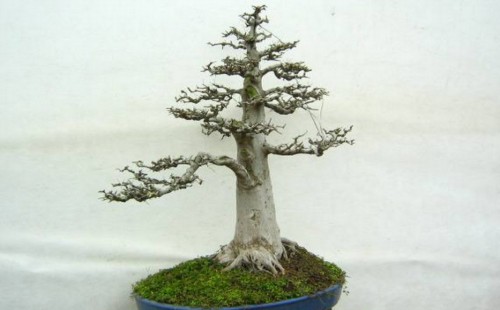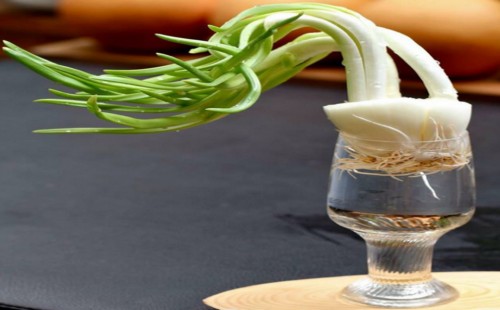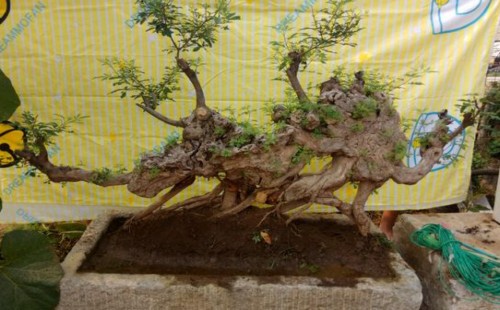The steps of making direct-drying bonsai
The straight dry style is also a common modeling design in the bonsai production process, which requires that the trunk is straight upward, the lower end is thicker and the upper end is thinner, and the lateral branches on both sides of the trunk remain flat, while the root system is often exposed around but appears vigorous and powerful. Viewed from the bonsai as a whole, the lower end branch remains the longest and oblique, while the middle branch keeps flat and tilts slightly downward, and the upper end branch rises slightly, the whole bonsai has obvious layers and outstanding ornamental effect. So, how to make straight-dry bonsai?

To make straight-dry bonsai, we first need to find the right trees, and if we don't find the right material, we need to cultivate them. The aim is to keep the trunk straight or slightly bent, looking tall as a whole, giving people a sense of soaring into the sky. Vertical bonsai is generally a single plant upright, but due to different tree species, tree age and modeling techniques, they often have their own advantages and distinctive features. Today, the editor will share with you the steps of making straight-dry bonsai, which can be simply understood as two steps in the core part.
First, cultivate trees
The production of straight-dry bonsai can use young trees or tree stumps, but the cultivation processes of the two are different. Next, the editor will briefly introduce the cultivation process of these two kinds of trees.
1. Cultivate straight-dry bonsai with young trees
In general, when the young tree grows to a certain size, the lower end of the young tree needs to be cut off for the first time, and the original section needs to maintain a 45-degree angle with the trunk and keep the angle between the left and right. After several years of cultivation, it is often necessary to carry out the second and third dry cutting treatment, and also need to pay attention to the angle of the cross section each time. At the same time of truncation treatment, it is often needed to be combined with trimming modeling, so that the size of the tree trunk can meet the basic requirements of bonsai production. Finally, transplant it into the pot to watch the pot to continue to cultivate.
For the cultivation process of young trees, it is often easy to process and produce according to the creator's ideas, conception and design, and the cultivated material is very novel, which is not different from the preset goal. But there is also an obvious drawback, that is, the training time is often too long, we need to have enough patience to complete the work.
2. Cultivate straight-dry bonsai with tree stump
In the process of obtaining stumps, we should choose those stumps that stand upright in the trunk as much as possible. After the stump is in hand, it first needs pruning and pruning, retaining the more natural part of the trunk, and then planting it in the sand to raise the stake, or directly planting it in a large flowerpot to store branches and dry. After several years of cultivation, wait until the branches and leaves grow in harmony with the trunk, and then transplant to the ornamental pot to continue to cultivate and build.
Second, bonsai modeling
The most important feature of straight-dry bonsai is that the trunk is straight or basically in an upright state, with tall and straight, strong characteristics, of course, it is also a typical feature of tree species. But when making a shape, we also need to choose a tree that is suitable for the shape. This kind of tree should have the characteristics of perfect root disk, rough and upright base, moderate trunk size, clear upper and lower thickness, and many lateral branches on the trunk. After determining the trees we need, we can do the styling.
In general, the process of cultivation and modeling of direct-dry bonsai is more difficult, which often needs to be carried out in all aspects, such as design, topping, promoting growth, building the whole plant and so on. However, the monotonous and rigid trees are required to create a sense of movement and charm, so that bonsai works have new ideas and have a breakthrough in creation.
First of all, the distribution of the main branches should be configured in accordance with certain rules. The first branch should extend to the left front or right front; the second branch should extend to the right or left for stability; the third branch extends backward to reflect the depth; but from the fourth branch, the position distribution is as described above, while the lower branch is nearly horizontal and drooping slightly, and the upward branch, the greater the tilt, which is very important in the performance of the young branch, can reflect the maximum sense of beauty. However, the sagging extent of the main branch often varies with different tree species.
Then there are two cases of zigzag knot, changeable direction, deviating from the trunk and not deviating from the trunk, but both need to use floating branches to create different forms of modeling effects. The more common ones are welcome style, natural wild cotton type, double straight stem towering shape and so on. Of course, the techniques used in each style are different, and the modeling effect has its own characteristics, which is worth us to learn and understand.
Time: 2019-05-25 Click:
- Prev

Methods and steps of hydroponic onion bonsai
Onion has a strong pungent taste, but the food made with it is more delicious, while often eating onions can also promote excretion, regulate blood lipids, blood pressure, prevent thrombosis and other effects. Often eat onions, can be a lot of benefits. Not only that.
- Next

The method of making bonsai with bauhinia pimples
Bauhinia knot is an evergreen tree species with the characteristics of loving yang but enduring shade, warm but cold, wet but not water-resistant, fertile but barren and so on. It has its peculiar shape, which can watch not only the leaves but also the type, so it is a kind of bonsai tree with high ornamental value. And this kind of bauhinia is tenacious.
Related
- Fuxing push coffee new agricultural production and marketing class: lack of small-scale processing plants
- Jujube rice field leisure farm deep ploughing Yilan for five years to create a space for organic food and play
- Nongyu Farm-A trial of organic papaya for brave women with advanced technology
- Four points for attention in the prevention and control of diseases and insect pests of edible fungi
- How to add nutrient solution to Edible Fungi
- Is there any good way to control edible fungus mites?
- Open Inoculation Technology of Edible Fungi
- Is there any clever way to use fertilizer for edible fungus in winter?
- What agents are used to kill the pathogens of edible fungi in the mushroom shed?
- Rapid drying of Edible Fungi

